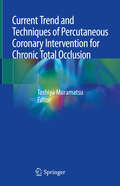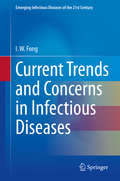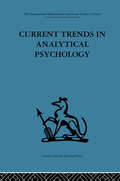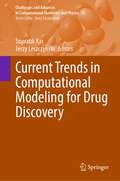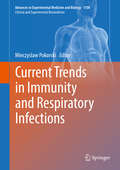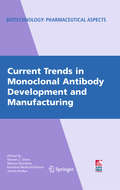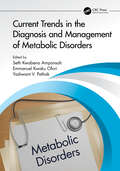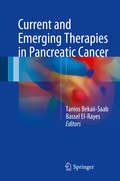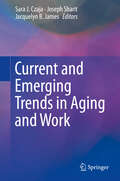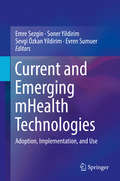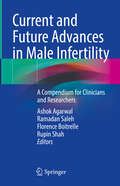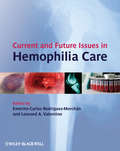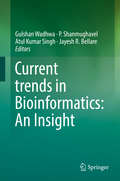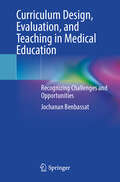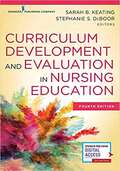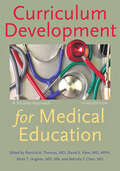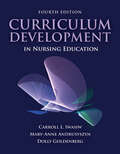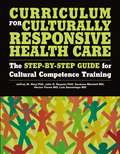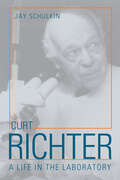- Table View
- List View
Current Trend and Techniques of Percutaneous Coronary Intervention for Chronic Total Occlusion
by Toshiya MuramatsuThis book discusses the clinical indications for chronic total occlusion (CTO) recanalization using percutaneous coronary intervention (PCI) and illustrates the recent academic findings on this constantly developing field of study. In addition to exploring the indications for revascularization and reading angiographies, the authors examine new strategies and techniques using innovative materials and equipment employing the antegrade, retrograde and their hybrid approaches, with a particular focus on the settings and management as well as the prevention of complications. They also describe the future potential of CTO PCI, with emphasis on how the latest advances in clinical science may be integrated into current and future therapies.Current Trend and Techniques of Percutaneous Coronary Intervention for Chronic Total Occlusion is an informative book providing academic insights for interventional cardiologists, vascular surgeons, clinical residents, medical students and scholars in the field of peripheral arterial CTO interventions.
Current Trends and Concerns in Infectious Diseases (Emerging Infectious Diseases of the 21st Century)
by I. W. FongA follow-up to Emerging Issues and Controversies in Infectious Diseases, this volume provides a comprehensive review of topical issues in infectious diseases, highlighting the controversies related to the newest findings and recommendations. Coverage includes trends and debates in HIV research, community-acquired pneumonia, H. pylori, progress in Hepatitis C treatment paired with the lack of progress on Hepatitis B, and the effects of climate change on infectious disease epidemiology, among others. This is an essential resource for practicing and academic physicians, investigators, residents, and fellows focused on infectious diseases, infection control, public health, and global health.
Current Trends in Analytical Psychology: Proceedings of the first international congress for analytical psychology
by Gerhard AdlerTavistock Press was established as a co-operative venture between the Tavistock Institute and Routledge & Kegan Paul (RKP) in the 1950s to produce a series of major contributions across the social sciences. This volume is part of a 2001 reissue of a selection of those important works which have since gone out of print, or are difficult to locate. Published by Routledge, 112 volumes in total are being brought together under the name The International Behavioural and Social Sciences Library: Classics from the Tavistock Press. Reproduced here in facsimile, this volume was originally published in 1961 and is available individually. The collection is also available in a number of themed mini-sets of between 5 and 13 volumes, or as a complete collection.
Current Trends in Biomedical Engineering
by Christiane Bertachini Lombello Patricia Aparecida da AnaThis book brings together the latest updates from various subareas of biomedical engineering, providing readers with a broad overview of the current state of the art and the technological trends to be refined in the coming years with the goal of improving human health. It shows the important advances in each subfield, rehabilitation technology, computational systems applied to health, and medical devices, with practical examples. It includes topics not covered in other books in the area, such as digital health, bioprinting, organs-on-a-chip, the open data paradigm, and electrical impedance tomography. It is a short and easy-to-read book, and provides bibliographic references for the reader to go deeper into their areas of interest. This book is aimed at a very broad group of professionals and students in biomedical engineering and related areas, seeking to contextualize and understand the latest scientific advances in each subfield of biomedical engineering, including neuroengineering, regenerative medicine, additive manufacturing orthosis, postural analysis of Parkinson's patients, modelling and simulation using biomechanical open data, regenerative medicine, advanced drug delivery systems, bioprinting, biophotonic and electrical impedance tomography.
Current Trends in Computational Modeling for Drug Discovery (Challenges and Advances in Computational Chemistry and Physics #35)
by Jerzy Leszczynski Supratik KarThis contributed volume offers a comprehensive discussion on how to design and discover pharmaceuticals using computational modeling techniques. The different chapters deal with the classical and most advanced techniques, theories, protocols, databases, and tools employed in computer-aided drug design (CADD) covering diverse therapeutic classes. Multiple components of Structure-Based Drug Discovery (SBDD) along with its workflow and associated challenges are presented while potential leads for Alzheimer’s disease (AD), antiviral agents, anti-human immunodeficiency virus (HIV) drugs, and leads for Severe Fever with Thrombocytopenia Syndrome Virus (SFTSV) disease are discussed in detail. Computational toxicological aspects in drug design and discovery, screening adverse effects, and existing or future in silico tools are highlighted, while a novel in silico tool, RASAR, which can be a major technique for small to big datasets when not much experimental data are present, is presented. The book also introduces the reader to the major drug databases covering drug molecules, chemicals, therapeutic targets, metabolomics, and peptides, which are great resources for drug discovery employing drug repurposing, high throughput, and virtual screening. This volume is a great tool for graduates, researchers, academics, and industrial scientists working in the fields of cheminformatics, bioinformatics, computational biology, and chemistry.
Current Trends in Immunity and Respiratory Infections (Advances in Experimental Medicine and Biology #1108)
by Mieczyslaw PokorskiThe purpose of this book is to disseminate and deliberate on the latest knowledge concerning immunity and its role in protection and fight against microorganism invasion. The articles tackle both humoral and cellular immunity, and their interconnectivity. The former involves B cells that recognize invading pathogens and create the antibody-mediated response, which when memorized provides future immunity. The latter involves mostly T cells, exemplified by cytotoxic or killer cell destroying the pathogens, or helper cells stimulating B cells to produce antibodies to bind and neutralize the pathogens. T cells act through release of cytokines, interleukins, and other bioactive mediators. Neutrophils play a key role in innate immunity against bacterial infections. The process of NETosis is a recently unraveled sophisticated defense mechanism, consisting of the formation of neutrophil extracellular traps that catch, immobilize, and remove pathogens from the body. Dysfunction of immunity is indisputably conducive to the propensity for infections, particularly respiratory tract infections, as the airways are the first line of defense against invading pathogens. Pathogens can rapidly evolve and adapt to avoid detection by the immune system. The case in point is the influenza virus. The articles report on the epidemiology, diagnostics, serology, complications, and the process of acquired immunity due to vaccination against influenza and influenza-like infections in recent epidemic seasons. The book is a blend of medical research and practice. It is intended for academic scientists, research scholars, clinicians, family doctors, and healthcare professionals.
Current Trends in Monoclonal Antibody Development and Manufacturing (Biotechnology: Pharmaceutical Aspects #XI)
by Wayne Gombotz Steven J. Shire Karoline Bechtold-Peters James AndyaMonoclonal antibodies represent one of the fastest growing areas of new drug development within the pharmaceutical industry. Several blockbuster products have been approved over the past several years including Rituxan, Remicade, Avastin, Humira, and Herceptin. In addition, over 300 new drugs are currently in clinical trials. With both large, established biotechnology companies and small start-ups involved in the development of this important class of molecules, monoclonal antibodies products will become increasingly prevalent over the next decade. Recently the regulatory review of monoclonal antibodies has been moved from Center for Biologics and Research to the Center for Drug Evaluation and Research (CDER) division of the US Food and Drug Administration. It is anticipated that CDER will expect a certain minimal amount of data to be provided as more of these products move through the regulatory pipeline. Current Trends in Monoclonal Antibody Development and Manufacturing will provide readers with an understanding of what is currently being done in the industry to develop, manufacture, and release monoclonal antibody products and what will be required for a successful regulatory submission.
Current Trends in the Diagnosis and Management of Metabolic Disorders
by Seth Kwabena AmponsahEmmanuel Kwaku OforiYashwant V. PathakThis volume provides an overview of the biochemical basis of metabolic diseases and molecular basis of chemical pathologies. Metabolic disorders occur when metabolic processes in the body are disrupted. They contribute a significant burden to human health globally. They can be congenital or acquired, for example, diabetes mellitus, obesity, metabolic syndrome, osteoporosis, osteopenia, mild-moderate hypovitaminosis D, erectile dysfunction, dyslipidemia, and thyroiditis. Metabolic disorders have gained significant importance due to the exponential increase in obesity worldwide. Early diagnosis of metabolic disorders is important in order to employ lifestyle and risk factor modification. Features: An overview of the biochemical basis of metabolic diseases and molecular basis of chemical pathologies Describes recent trends in diagnosis of metabolic disorders Discusses management and treatment of metabolic diseases Allows quick identification and retrieval of material by researchers learning the efficacy, associated dosage and toxicity of each of the classes of compounds Suitable globally for graduate and postgraduate students studying metabolic diseases
Current Understanding and Treatment of Gliomas (Cancer Treatment and Research #163)
by Jeffrey Raizer Andrew ParsaThis book reviews the significant advances in our understanding of glioma biology that have been achieved during the past decade and describes in detail the resultant new approaches to treatment. Improvements in surgical techniques, radiation therapy, and chemotherapy are comprehensively covered, with discussion of their impact in decreasing patient morbidity and increasing survival. In addition, individual chapters are devoted specifically to current treatment for low-grade gliomas, anaplastic gliomas, and glioblastoma multiforme. Other topics addressed include treatment of the elderly patient, investigating emerging therapies from small molecules to immunotherapy and palliative care. This timely book will be a valuable source of up-to-date information for practitioners and will also be of interest to researchers.
Current and Emerging Therapies in Pancreatic Cancer
by Tanios Bekaii-Saab Bassel El-RayesThis book provides a comprehensive, state-of-the art review of current and new therapies in treating pancreatic cancer. In addition to discussing the current landscape for treating various stages of pancreatic cancer, the text highlights several standard and emerging approaches, with a particular emphasis on novel endoscopic, surgical, chemotherapeutic, radiotherapeutic, targeted, and immunotherapeutic strategies. The volume also features concepts on the potential economic effects associated with the development and implementation of new treatments in pancreatic cancer. Written by experts from a variety of integrative disciplines, Current and Emerging Therapies in Pancreatic Cancer is a valuable resource for oncologists, gastroenterologists, surgeons, and other professionals who treat and manage patients with pancreatic cancer.
Current and Emerging Trends in Aging and Work
by Sara J. Czaja Joseph Sharit Jacquelyn B. JamesThis timely volume provides an up-to-date and comprehensive summary about what is known about aging and work and addresses the challenges and opportunities confronting older workers and organizations. The authors describe current and emerging topics related to work and aging adults such as working in teams, the increasing diversity of the labor force, work and caregiving, the implications of technology for an aging workforce, and health and wellness issues. The authorship is international; the authors are renowned for their respective work in the topical areas and represent a broad range of disciplines within academia, as well as offer perspectives from government and policy. Jobs, organizations, the labor market, and the workforce are experiencing dramatic change. Workers of all ages, including older workers, need to interact with the wide variety of ubiquitous technologies that are reshaping work processes, job content, work settings, communication strategies, and the delivery of training, and this book aims to update readers on the particular issues facing today’s aging adults in the workplace. The chapters’ broad and inclusive scope encompasses:Workplace aging and jobs in the 21st centuryThe retirement income security outlook for older workersPopulation aging, age discrimination, and age discrimination protectionsOlder workers and the contemporary labor marketThe role of aging, age diversity, and age heterogeneity within teamsThe intersection of family caregiving and work Current and Emerging Trends in Aging and Work is relevant to a broad audience of academic researchers, practitioners, and students in psychology, sociology, management, engineering (industrial and human factors), the health sciences, gerontology/geriatrics, and public health. It is also a useful resource for government and policy leaders, as well as workers and managers in the public and private sectors.
Current and Emerging mHealth Technologies
by Emre Sezgin Evren Sumuer Soner Yildirim Sevgi Özkan-YildirimThe promise and prospects for mobile technologies in healthcare service delivery—particularly as experienced by patients and other users—are the focus of this forward-looking volume. Its detailed sociotechnical perspective takes in factors influencing patient and provider adoption of technological advances, in addition to the well-known cost and accessibility advantages. Enlightening reports show mobile health technologies in multiple contexts as an impetus for behavioral change, a means of monitoring health changes, a growing trend in service delivery, and an emerging health frontier worldwide. Together, these chapters point to the continued expansion—and global reach—of mobile technology in the next stage of healthcare services. Included in the coverage:Behavior change techniques used in mobile applications targeting physical activity: a systematic reviewMobile health integration in pregnancyUnintended users, uses, and consequences of mobile weight loss apps: using eating disorders as a case studyIntention vs. perception: understanding the differences in physicians’ attitudes towards mobile health applicationsHealthGuide: a personalized mobile patient guidance systemAdoption of sensors in mobile health Current and Emerging mHealth Technologies is salient reading for researchers interested in mobile health development and implementation as well as technology adoption, and mobile health system developers and managers who are interested in the implications of mobile health use by patients and/or healthcare professionals. It can also be used for courses in technology adoption and health technologies.
Current and Future Advances in Male Infertility: A Compendium for Clinicians and Researchers
by Ashok Agarwal Florence Boitrelle Ramadan Saleh Rupin ShahInfertility is an important health problem affecting around 15% of couples worldwide, with profound psycho-social consequences and impairment of patients’ quality of life. It has been shown that the male factor is solely and partially implicated in 20-50% of the cases of infertility. Male infertility is a complex issue that can be related to a variety of congenital or acquired factors that lead to a decline in the quantity and/or the quality of semen. Over the recent years, there have been major advances in basic understanding of the factors that regulate male fertility, the diagnostic tests for assessment of male fertility potential, and the therapeutic options for the management of male subfertility/infertility. However, despite advances in technologies and diagnostic methods in the field of andrology, there remains a significant subset of these subfertile men who are classified as having unexplained or idiopathic male infertility. In addition, there are ongoing debates and controversies on the clinical management of infertile men under certain conditions like varicocele, genital tract inflammation/infection or non-obstructive azoospermia. This book discusses advances in cellular, molecular, and genetic aspects of spermatogenesis and sperm evaluation in the context of clinical scenarios. It also addresses clinical dilemmas and controversies through a discussion of the basic science underlying these conditions. The authors form an impressive international collaboration to provide a unique perspective that specializes in all key areas of andrology. Current and Future Advances in Male Infertility provides insights into strategies to reduce the burden of male gonadotoxins, to enhance men’s fecundity and to help optimize the care of infertile men. It aims to bridge the gap between researchers and clinicians by integrating basic science and clinical application.
Current and Future Issues in Hemophilia Care
by E. Carlos Rodriguez-Merchan Leonard A. ValentinoAs haemophilia is a life-long condition, continuing supervision by a group of medical personnel is required. In many countries this is provided by comprehensive care haemophilia centres where staff of all specialities concerned with treatment- haematologists, paediatricians, nurses, physiotherapists, orthopaedic surgeons - have specialized knowledge.This new book is a definitive resource on the current aspects and issues around haemophilia. Complications of haemophilia care are well covered in chapters on inhibitors, and musculoskeletal problems, as are all the latest developments in the field of haemophilia.
Current and Future Trends in Health and Medical Informatics (Studies in Computational Intelligence #1112)
by Kevin Daimi Abeer Alsadoon Sara Seabra Dos ReisThis book is comprehensive with most of its contents following the recommendations of international health and medical informatics associations and societies. To this extent it covers the areas of healthcare and medical information systems, management of healthcare and medical information systems, healthcare/medical information systems supporting patients and the public, healthcare/medical networking and care sharing, medical imaging and 3D/4D surgical visualization, design and analysis of health/medical records, health/medical data representation and analysis, simulation and modeling in healthcare, and health and medical informatics education.The book provides an excellent professional development resource for educators and practitioners on the state-of-the-art Health and Medical Informatics. It covers many areas and topics of Health and Medical Informatics and contributes toward the enhancement of the community outreach and engagement component of Health and Medical Informatics. Various techniques, methods, and approaches adopted by Health and Medical Informatics experts in the field are introduced. Furthermore, it provides detailed explanation of the Health and Medical Informatics concepts that are aptly reinforced by applications and some practical examples and a road map of future trends that are suitable for innovative Health and Medical Informatics.
Current trends in Bioinformatics: An Insight
by Gulshan Wadhwa P. Shanmughavel Atul Kumar Singh Jayesh R. BellareThis book highlights the latest breakthrough developments in bioinformatics. It presents a series of timely, in-depth reviews, drug clinical trial studies, biodiversity informatics and thematic issues. In addition, it includes insightful reviews on advances in computational molecular/structural biology, which address areas such as computing in biomedicine and genomics, computational proteomics and systems biology, and metabolic pathway engineering. Innovations in these fields have direct impacts on key issues related to healthcare, medicine, genetic disorders, the development of agricultural products, renewable energy, and environmental protection. Written by respected leaders in the field and covering a wide range of topics involving the integration of biology with computer and information science, the book offers an ideal basis for teaching at the undergraduate and graduate levels. It can also be used for self-instruction by research investigators interested in applying bioinformatics-based analytical methods and information technologists working with academic and industrial laboratories.
Curriculum Design, Evaluation, and Teaching in Medical Education: Recognizing Challenges and Opportunities
by Jochanan BenbassatThis concise and challenging examination of medical education aims to discuss curriculum design and evaluation in medical schools and to take a fresh look at current trends in patient care and continuing education teaching methods. The ideas and insights provided here are based on the author's long career in clinical practice and teaching medical students and residents. Medical education is no exception to the changes at every level in medicine. For example, the ready access to medical information via the Internet and other media has produced smarter and informed patients. Multi-specialty hospital practice has replaced the individual 'doctor-patient' relationship, perhaps compromising patient care to some extent. New subjects have been added over the years to medical curricula. Nevertheless, there has often been a reluctance to remove older topics, possibly limiting the medical training course's ability to develop as expected. The transition from theories of higher education to the reality of curriculum planning and design is a huge leap. An important question is how to translate the mission of higher education in general which has been variably described as a training of 'reflective individuals' who 'possess both culture and expertise' and can 'master any subject with facility' into a coherent teaching program. The mission of medical education includes the promotion of professionalism in learners by including courses in medical ethics that have become integral to medical education in the USA. However, despite the development of standards and competencies related to professionalism, there is no consensus on the specific goals of medical ethics education, the knowledge and skills expected of learners, and the best pedagogical methods and processes for their implementation and assessment. A significant contribution to the clinical teaching literature, Curriculum Design, Evaluation, and Teaching in Medical Education should be of interest to a variety of readers, including clinical educators, administrators, health care professionals, and especially residency directors.
Curriculum Development And Evaluation In Nursing Education
by Sarah B. KeatingCourse design for nursing school courses require strict adherence to the most recent research, theory, and techniques to make future nursing students competitive. Nurse educator books need to be revamped to reflect these improvements in nurse education. The fourth edition of Curriculum Development and Evaluation in Nursing Education, Fourth Edition, provides a clear springboard for graduate students and faculty to learn how to focus course material and filter out irrelevant material and approaches. These chapters have been updated to reflect best practices in curriculum development and approval processes for an educational environment that is constantly changing, as well as strategies for applying theory, educational taxonomies, team-building, needs assessment, and the frame factor's model. Nursing educator books so rarely thoroughly prepare educators to assist with providing excellent methods for instructing ADN, BSN, master's and doctoral education. Any medical or nurse school will benefit from the detailed knowledge and practice applications necessary to help faculty participate in academia's various essential roles, including instruction, curriculum, and evaluation. With a focus on interdisciplinary collaboration, the book addresses the growth of simulation, how to help new faculty transition into the academic role, and use of curriculum in both practice and academic settings. Additionally, the book describes the history and evolution of current nursing curricula and presents the theories, concepts, and tools necessary for curriculum development. Chapters include objectives, discussion points, and learning activities, and this book provides assistance with achieving CNE certification review.
Curriculum Development for Medical Education: A Six-Step Approach
by Patricia A. Thomas David E. Kern Mark T. Hughes Belinda Y. ChenThe third edition of this invaluable text reflects significant changes driving curriculum development and renewal throughout medical education.Based on a proven six-step model and including examples and questions to guide application of those timeless principles, Curriculum Development for Medical Education is a practical guidebook for all faculty members and administrators responsible for the educational experiences of medical students, residents, fellows, and clinical practitioners.Incorporating revisions driven by calls for reform and innovations in medical education that challenge established teaching models, the third edition includes an awareness of new accreditation standards and regulatory guidelines. The authors have expanded their discussion of survey methodology for needs assessment and stress the importance of writing competency-based goals and objectives that incorporate milestones, entrustable professional activities, and observable practice activities. With updated examples focusing on interprofessional education, collaborative practice, and educational technology, they describe educational strategies that incorporate the new science of learning. A completely new chapter presents the unique challenges of curriculum development for large, long, and integrated curricula.
Curriculum Development in Nursing Education
by Carroll L. Iwasiw Mary-Anne Andrusyszyn Dolly GoldenbergCurriculum Development in Nursing Education, Fourth Edition provides nursing students with the theory and practical ideas necessary to develop an evidence-based, context-relevant, unified curriculum.
Curriculum Development in Nursing: Process and Innovation
by Leana R. Uys Nomthandazo S. GweleEducation for nurses and allied health professionals is being radically overhauled both in the UK and overseas. Curriculum Development in Nursing offers nurse educators a single text that covers curriculum development processes, and highlights case study examples on innovation in approaches to nurse education. Written by internationally well-known authors based in South Africa, who take a truly international perspective looking at education in the UK, Europe and the US, as well as Africa and the Middle East, this book is an essential guides to curriculum development and will be an invaluable resource for nurse educators and postgraduate nursing students internationally.
Curriculum for Culturally Responsive Health Care: The Step-by-Step Guide for Cultural Competence Training
by Suzanne Mitchell Jeffrey Ring Julie NyquistThis is a creative, comprehensive and user-friendly manual comprising a curriculum for residencies and medical schools looking to implement new, or enhance existing, curricula in culturally responsive care. It meticulously describes teaching strategies that will prove engaging to learners and faculty alike, challenging them to grow in their attitudes, awareness, desire, knowledge and skills to effectively practice culturally responsive medicine. It demonstrates commitment to teaching culturally responsive medicine towards the elimination of health disparities, be they related to gender, race/ethnicity, income, sexual orientation, religious background or world view.The manual includes a step-by-step guide for each year of the curriculum, with detailed session descriptions, and sections on teaching techniques, evaluation tools, cultural competence exercises, together with information on further resources. The curriculum provides a solid foundation upon which educational programs can build as they evolve to meet the needs of patients and their communities toward preventing and treating illness, and improving access to excellence in medical care.
Curt Richter: A Life in the Laboratory
by Jay SchulkinIn the first half of the twentieth century, psychology was a discipline in search of scientific legitimacy. Debates raged over how much of human and animal behavior is instinctive and how much is learned, and how behavior could be quantified accurately. At the Johns Hopkins University's new Phipps Psychiatric Clinic, Curt P. Richter stood aside from these heated theoretical arguments, choosing instead to apply his data-collection methods, innovative measurement techniques, playful sense of exploration, and consummate surgical skill to laboratory examinations of the biological basis of behavior. From identifying the biological clocks that govern behavior and physiology to observing the self-regulation of nutrient levels by the body, the cyclical nature of some mental illnesses, and the causes of hopelessness, Richter's wide-ranging discoveries not only influenced the burgeoning field of psychobiology and paved the way for later researchers but also often had implications for the treatment of patients in the clinic. At the time of his death in 1988, Richter left behind a massive collection of laboratory data. For this book, Jay Schulkin mined six decades of Richter's archived research data, personal documents, and interviews to flesh out an engaging portrait of a "laboratory artisan" in the context of his work.
Curves, Twists and Bends: A Practical Guide to Pilates for Scoliosis
by Alan Herdman Annette WellingsWritten in response to the many requests for a practical and accessible guide to exercise for scoliosis sufferers, Curves, Twists and Bends combines the experience of Annette Wellings, who has major scoliosis, with that of Alan Herdman, the UK's leading Pilates teacher. This clear and concise book explains what scoliosis is, its symptoms, and its physical and psychological impact. It includes a series of Pilates exercises, designed by the authors specifically to promote flexibility, posture and muscle strength in scoliosis sufferers, and also vital information on what exercises to avoid. It offers basic strategies and practical tips for living with the condition, including useful advice on diet, rest, sitting, carrying and how to dress. Written with the full range of scoliosis sufferers in mind, Pilates for Scoliosis emphasises the importance and feasibility of gentle exercise for keeping the body as healthy and flexible as possible. Curves, Twists and Bends: A Practical Guide to Pilates for Scoliosis will be indispensible to individuals with scoliosis and their families as well as to physical therapists, Pilates instructors and other professionals who advise scoliosis patients on exercise and lifestyle options.
Curvilinear Micromagnetism: From Fundamentals to Applications (Topics in Applied Physics #146)
by Denys Makarov Denis D. ShekaThis is the first book providing overview of magnetism in curved geometries, highlighting numerous peculiarities emerging from geometrically curved magnetic objects such as curved wires, shells, as well as complex three-dimensional structures. Extending planar two-dimensional structures into the three-dimensional space has become a general trend in multiple disciplines across electronics, photonics, plasmonics and magnetics. This approach provides the means to modify conventional and even launch novel functionalities by tailoring the local curvature of an object. The book covers the theory of curvilinear micromagnetism as well as experimental studies of geometrically curved magnets including both fabrication and characterization. With its coverage of fundamental aspects, together with exploration of numerous applications across magnonics, bio-engineering, soft robotics and shapeable magnetoelectronics, this edited collection is ideal for all scientists in academia and industry seeking an overview and wishing to keep abreast of advances in the novel field of curvilinear micromagnetism. It provides easy but comprehensive access to the field for newcomers, and can be used for graduate-level courses on this subject.
